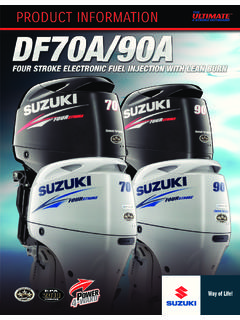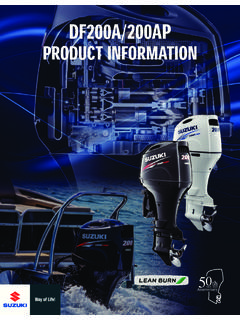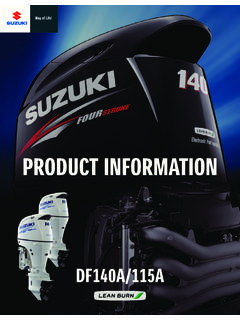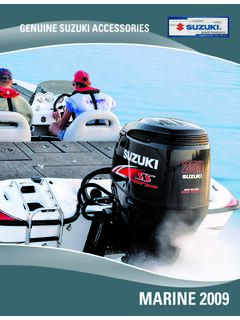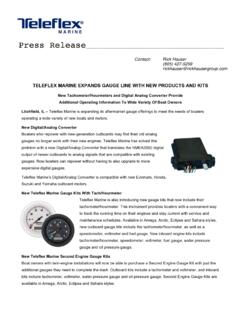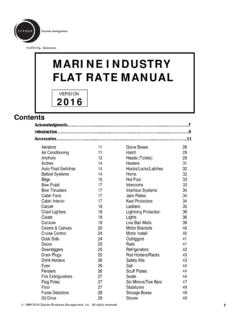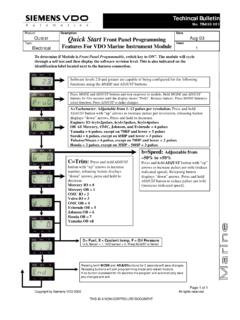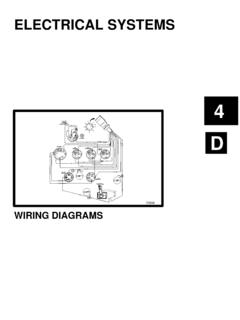Transcription of SUZUKI DF350A A REVOLUTION IN INNOVATION
1 SUZUKI DF350A A REVOLUTION IN INNOVATIONGEKI: PARTING SEASSUZUKI DF350A A REVOLUTION IN INNOVATIONGEKI: PARTING SEAS A Force To Match The Power Of Nature And The Sea Representing SUZUKI s Identity And Heritage. A Symbol Of Our Passion And Commitment To The Ultimate In Marine AND ENGINEERED LIKE NO OTHERIt s no secret that bigger boats are growing in popularity, and that is driving demand for more powerful outboard motors. In fact, whether it's offshore fishing boats, cruisers and runabouts, even pontoon boats, many boat builders are looking to replace stern drives and inboard designs with newer, bigger outboards are more efficient, more compact, easier and less expensive to maintain, and more straightforward when it comes time to repower.
2 But building a bigger, more powerful outboard is not without its challenges. Bigger can mean heavier, which impacts fuel efficiency and the balance of the boat . More power can require a more complex design, which affects reliability and durability. MORE THAN 350 HORSEPOWERI m sure you ve all seen incredibly powerful drag racing cars spinning their tires because they lack traction. They can simply bolt on bigger tires or adjust the chassis to get the power to the ground. It s definitely not that simple when it comes to power and , odd as it may Generating more power is not enough to guarantee better performance.
3 You have to be able to harness that power and transfer it to water brings in other factors such as gear and propeller design, lower unit hydrodynamics, engine mounting, and a lot Marine decided to take on these challenges and embark on a major, multi-year engineering program to build the biggest, most powerful outboard in our WE CALL IT "GEKI"When facing that challenge, SUZUKI engineers came up with a symbol to inspire the team in their work. In Japanese it s called Geki, which translates to parting seas. In other words, a force to match the power of nature and the that is also the perfect description of the newest, biggest, most powerful engine in the SUZUKI s not all that hard to make more horsepower.
4 You can increase displacement, add a turbocharger or supercharger, or make other performance tweaks. The hard part is using all that power effectively, getting it to the water so the boat performs at its 350 HORSEPOWER SOLUTIOND esigning an outboard with 350 horsepower may sound like a fairly straightforward task, but when you add in the parameters of lighter weight, improved fuel economy and rock-solid reliability, things get much more started with a V6 engine with liter displacement, which would be the largest displacement in the V6 category. Then we had to figure out how to get 80 horsepower per liter and still achieve our other solution was to increase the compression ratio to :1, the highest compression ratio ever for a production outboard engine.
5 In order to make this work without knocking (a typical problem at this ratio), we developed a dual injector system that mixes highly atomized fuel with cooler air to provide optimal conditions for complete and controlled INJECTORS FOR BOTH COOLING AND POWEROur decision to use a :1 compression ratio provided us with the power we wanted, but also introduced several design challenges. With the Dual Louver System and the Direct Intake System, we got the dryer and cooler intake air that we needed. Next was fuel fuel does two things, it atomizes the fuel and, incidentally, it cools the cylinder. Cooling the cylinder was an important factor in minimizing knock.
6 To achieve the power we wanted, we needed to inject 100% of the fuel into the cylinder at once, at a precise time, and at a precise angle to both cool the cylinder and to allow combustion in the combustion chamber. We developed a new Dual Injector System to accomplish these objectives. Using two smaller injectors provided the precision we needed, plus it achieved improved atomization. In fact, we were able to increase output by 3% without causing INJECTORTHE HUMBLE PISTON MEETS ADVANCED TECHNOLOGYTo help the piston withstand the added lateral pressure, we switched from the standard surface texture treatment to shot peening.
7 Shot peening creates fine dimples on the surface that evenly distribute the pressure created during combustion. It s a more expensive, and far more involved manufacturing process, but one that makes it possible to create a piston worthy of the ULTIMATE INTAKE SYSTEM AND DUAL LOUVER SYSTEM FOR COOL AND DRY AIRW hile riding a fast-moving train on a rainy day, one of our engineers noticed the water particles streaming across the window. That was it! He realized that, at speed, water particles could be directed, trapped and drained countless trials, we developed a Dual Louver System that resulted in eliminating water intake, even in the face of the most severe on-the-water Dual Louver System incorporates a double shield of blades, each one designed in a dog-leg shape.
8 The outer row of blades capture any spray from the boat and the inner louvers catch and drain the remaining mist. As a result, intake air temperature is free of moisture and no higher than 10 above DUAL LOUVER SYSTEMA fter years of outboard design, SUZUKI engineers knew that the shape of the lower unit and the design of the propeller would have a critical impact on performance. The increased power of the new engine required more powerful gears, and more powerful gears were typically larger. After considering alternatives, an innovative idea was proposed: design a contra-rotating dual propeller system. The contra-rotating propeller would certainly provide more grip underwater, and because contra-rotating propellers distribute the engine torque evenly over two propellers, the torque per propeller decreases and gear diameter can be reduced.
9 A reduction in gear diameter could then lead to the design of a smaller, more hydrodynamic gear DUAL PROP SYSTEMDEVELOPMENT OF SUZUKI S FIRST CONTRA-ROTATING PROPELLERGEAR CASE DESIGN Designing the actual shape of the gear case was another significant challenge. Top speeds, even with the new contra-rotating propeller, were not up to expectations. Analysis revealed that cavitation voids around the gear case were still causing excessive resistance. While SUZUKI engineers had extensive experience in designing gear case profiles, these new, faster speeds presented new challenges. After many late nights, repeated simulations using computational fluid dynamics (CFD) and countless test drives, a breakthrough design was developed that both minimized resistance and provided the most efficient flow of water to the WATER INLETDUAL WATER INTAKESD esigning the shape of the gear case also required repositioning the water intakes.
10 It was important to arrange the main and sub intakes as far apart from each other as possible, and to design them to ensure a reliable amount of cooling water, especially at high speeds. On the DF350A , the best results were achieved when the main intake was positioned at the front of the gear case, with the secondary intake located just above the PROVEN TECHNOLOGIES ARE BACK IN THE DF350 ASUZUKI S LEAN BURN CONTROL SYSTEMS uzuki s innovative Lean Burn Control System was first introduced on the DF90A and 70A to great acclaim. The system predicts fuel needs according to operating conditions, allowing the engine to run on a leaner, more efficient air-fuel ratio.




